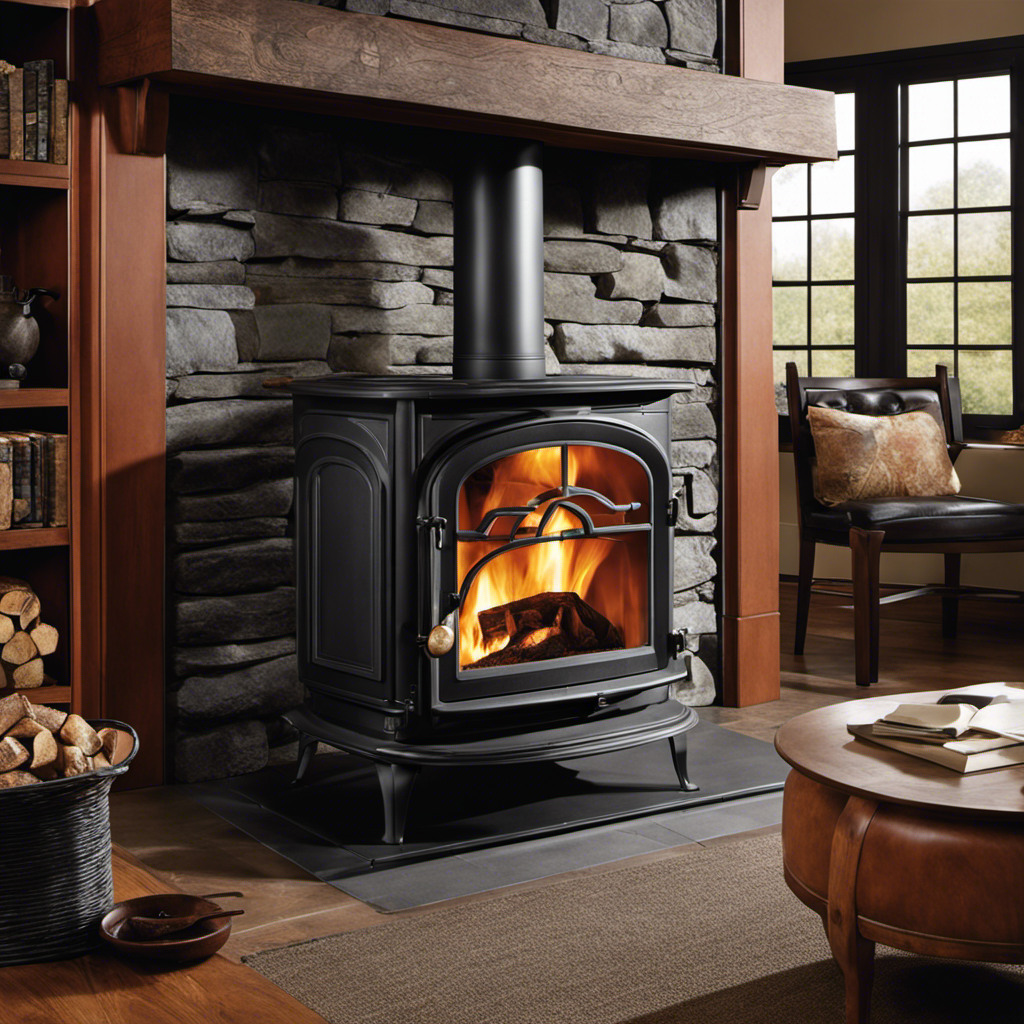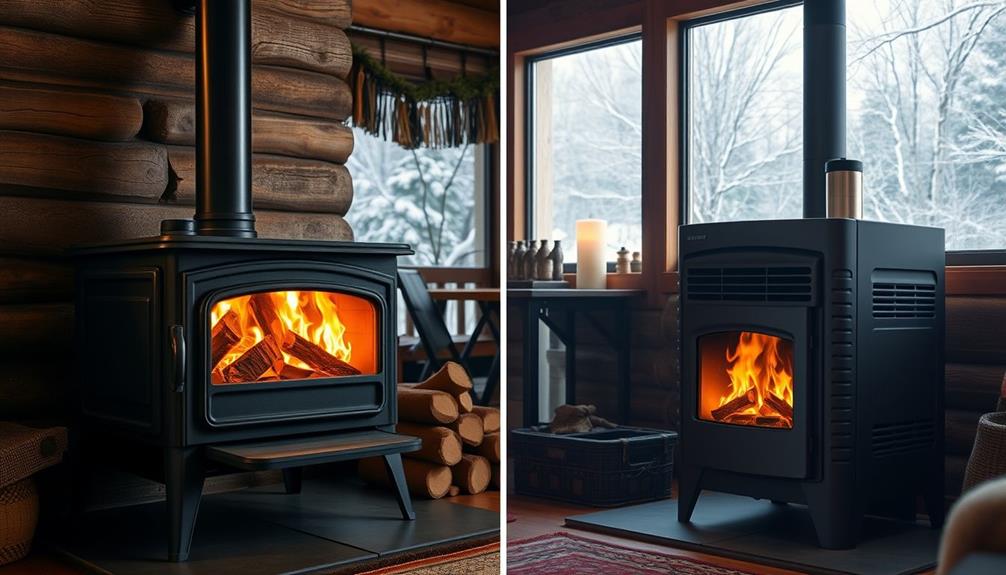Liberate your taste buds and explore the endless possibilities of your outdoor wood stove with these straightforward yet delicious recipes.
We’ve got everything from grilled steaks to smoked ribs, and even toasted sandwiches that will leave you craving for more.
With our practical and creative ideas, you’ll be able to make the most out of your wood stove and impress your friends and family with delicious meals cooked in the great outdoors.
Get ready to elevate your outdoor cooking game to new heights!
Key Takeaways
- Preheat the outdoor wood stove to a high temperature before grilling.
- Use a meat thermometer to ensure proper grilling temperature and time.
- Experiment with different marinades and seasonings to enhance the flavor of grilled meats and seafood.
- Get creative with different fillings and cooking techniques for sandwiches and sides.
Grilled Steaks
We can’t wait to sink our teeth into those juicy grilled steaks with the perfect sear and smoky flavor. Grilling steaks isn’t only a delicious way to cook them, but it also brings out their natural flavors and creates a mouthwatering experience.
To achieve that perfect sear, preheat your outdoor wood stove to a high temperature and make sure the grates are clean and well-oiled. Season your steaks with salt and pepper, and place them directly on the grill. Cook them for about 4-6 minutes per side, depending on the thickness and desired doneness.
Remember to let the steaks rest for a few minutes before slicing to retain their juiciness. Serve them with grilled vegetables for a well-rounded and satisfying meal.
Vegetable Skewer
Let’s fire up the grill and make some mouthwatering vegetable skewers with a variety of colorful veggies and a tangy marinade.
Grilling vegetables is a great way to bring out their natural flavors and create a delicious and healthy meal.
To make these skewers, start by choosing a selection of your favorite vegetables. Bell peppers, zucchini, mushrooms, and red onions are all excellent choices. Cut the vegetables into bite-sized pieces and thread them onto skewers.
Next, prepare a tangy marinade using ingredients like olive oil, lemon juice, garlic, and herbs. Brush the marinade onto the skewered vegetables and let them marinate for at least 30 minutes.
Then, grill the skewers over medium heat until the vegetables are tender and slightly charred.
Serve these grilled vegetable skewers as a side dish or even as a main course by adding some grilled tofu or roasted vegetables.
Enjoy the flavors of summer with this liberating and delicious meal!
Stove Pizza
We just finished making a delicious stove pizza with our outdoor wood stove. It was absolutely divine! The smell of the wood burning and the crispness of the crust made for the perfect combination. Here are some toppings that you can try on your stove pizza:
- Fresh mozzarella cheese
- Sliced tomatoes
- Fresh basil leaves
- Pepperoni slices
To make the homemade pizza dough, you’ll need flour, yeast, salt, water, and olive oil. The process is quite simple and the end result is worth it. Just mix the ingredients together, let the dough rise, and then roll it out into your desired shape.
Now that we’ve satisfied our pizza cravings, let’s move on to the next mouthwatering recipe: BBQ chicken.
BBQ Chicken
When it comes to BBQ chicken, there are a few key points to consider.
First, the marinade options are endless – from tangy and sweet to spicy and smoky, you can easily customize the flavor to your liking.
Second, grilling temperature and time are crucial for achieving that perfect balance of crispy skin and juicy meat.
Lastly, don’t forget about serving suggestions and sides – whether you prefer classic coleslaw and cornbread or a fresh summer salad, the right accompaniments can elevate your BBQ chicken to a whole new level.
Marinade Options for Flavor
We have found three delicious marinade options that will add incredible flavor to your BBQ chicken. Whether you’re looking for alternative marinade recipes or vegetarian marinade options, we’ve got you covered.
Check out these mouthwatering options:
-
Lemon Herb Marinade: A tangy blend of fresh lemon juice, minced garlic, chopped herbs, and olive oil. It will give your chicken a refreshing and zesty kick.
-
Teriyaki Marinade: This classic marinade combines soy sauce, ginger, garlic, brown sugar, and sesame oil. It’s perfect for those who enjoy a sweet and savory flavor profile.
-
Spicy Chipotle Marinade: For those who like it hot, this marinade is a winner. It features chipotle peppers in adobo sauce, lime juice, honey, and spices. It will add a fiery kick to your chicken.
Now that you have your marinade options ready, let’s move on to grilling temperature and time to ensure your chicken turns out perfectly juicy and flavorful.
Grilling Temperature and Time
To achieve the best results, we recommend using a meat thermometer to ensure the BBQ chicken reaches the proper internal temperature and grilling it for the appropriate amount of time. Grilling techniques and seasoning options can greatly enhance the flavor and tenderness of your chicken. Here is a table summarizing the recommended grilling temperature and time for different cuts of chicken:
| Chicken Cut | Grilling Temperature (Fahrenheit) | Grilling Time (minutes per side) |
|---|---|---|
| Chicken Breast | 375-400 | 6-8 |
| Chicken Thighs | 375-400 | 8-10 |
| Chicken Drumsticks | 375-400 | 10-12 |
| Whole Chicken | 350-375 | 20-25 per pound |
Remember to preheat your grill and oil the grates before cooking. Experiment with different seasoning options such as marinades, dry rubs, or herb butter to add flavor to your chicken. Don’t forget to let the chicken rest for a few minutes before serving to allow the juices to redistribute. Enjoy your perfectly grilled chicken!
Serving Suggestions and Sides
As we discuss serving suggestions and sides for our BBQ chicken, let’s consider incorporating a tangy coleslaw and some grilled corn on the cob for a complete and delicious meal. These options will add a burst of flavor and freshness to our barbeque feast.
Here are some serving suggestions and vegetarian options to consider:
-
Tangy Coleslaw: A creamy and tangy coleslaw made with shredded cabbage, carrots, and a zesty dressing is the perfect complement to the smoky flavors of the BBQ chicken. It adds a refreshing crunch and balances out the richness of the meat.
-
Grilled Corn on the Cob: Grilling corn on the cob gives it a smoky and charred flavor that pairs beautifully with BBQ chicken. Serve it with a pat of butter and a sprinkle of salt for a simple and delicious side dish.
-
Vegetarian Options: For our vegetarian friends, consider offering grilled vegetable skewers or a refreshing quinoa salad. These options provide a satisfying and flavorful alternative to the chicken.
Grilled Seafood
Let’s fire up the grill and enjoy some mouthwatering grilled seafood tonight! Grilled shrimp is a classic favorite that never fails to impress. The key to achieving that perfect smoky flavor is in the seafood marinades. Try marinating your shrimp in a mixture of fresh lemon juice, garlic, and olive oil for a tangy and aromatic twist. For those who prefer a spicy kick, a marinade made with chili flakes, lime juice, and cilantro will elevate the flavors of your shrimp to a whole new level.
To ensure your grilled seafood turns out succulent and flavorful, it’s important to preheat your grill and oil the grates before cooking. This will prevent your seafood from sticking and help achieve those beautiful grill marks. Remember to keep a close eye on your shrimp as they cook quickly and can become rubbery if overdone.
Sausage and Peppers
We can’t resist the mouthwatering combination of juicy sausage and peppers sizzling on the grill. There’s just something about the smoky flavor of grilled sausage and the sweet and tangy taste of peppers that makes our taste buds dance with joy.
To help you make the most out of your grilling experience, we’ve compiled a list of grilling techniques for vegetables that will take your sausage and peppers to the next level:
- Marinate the peppers in a mixture of olive oil, balsamic vinegar, and herbs to enhance their flavor.
- Precook the sausage before grilling to ensure it’s fully cooked and juicy.
- Use a vegetable basket or skewers to prevent the peppers from falling through the grill grates.
- Grill the sausage and peppers over medium-high heat for that perfect charred and smoky flavor.
Now that we’ve satisfied your grilling cravings for sausage and peppers, let’s move on to the next mouthwatering topic: smoked ribs.
Smoked Ribs
Have you ever tried smoking ribs for that perfect smoky flavor and fall-off-the-bone tenderness? If not, you’re missing out on a culinary experience that will leave you craving for more.
When it comes to smoked ribs, the marinade options are endless. From tangy and sweet BBQ sauces to savory dry rubs, there’s something for everyone’s taste buds. One popular marinade option is a combination of brown sugar, paprika, garlic powder, and cayenne pepper. This blend creates a mouthwatering crust while infusing the meat with a smoky and slightly spicy kick. Another option is a classic vinegar-based marinade that adds a tangy and refreshing twist to the ribs.
Whichever marinade you choose, make sure to let the flavors penetrate the meat overnight for maximum impact.
Now that you’ve mastered the art of smoking ribs, let’s move on to another delicious topic: toasted sandwiches.
Toasted Sandwiches
We can’t resist the gooey goodness of a toasted sandwich with melted cheese and crispy bread. When it comes to toasted sandwich variations, the possibilities are endless. Here are some ideas to get your taste buds tingling:
-
Classic grilled cheese: Simple, yet oh so satisfying. The combination of melted cheddar cheese and buttery, toasted bread is hard to beat.
-
Caprese panini: Take your sandwich to a whole new level with fresh mozzarella, juicy tomatoes, and fragrant basil leaves. It’s like a taste of Italy in every bite.
-
Turkey and cranberry melt: Perfect for those leftover Thanksgiving turkey slices. Add some tangy cranberry sauce and a sprinkle of grated Parmesan for a delicious twist.
-
Bacon, avocado, and tomato: Indulge in the ultimate comfort food with crispy bacon, creamy avocado, and juicy tomato slices. It’s a flavor explosion that will leave you craving more.
Now that we’ve satisfied your sandwich cravings, let’s move on to the next delectable topic: potatoes and bacon.
What Are Some Easy Recipes to Try on an Outdoor Wood Stove to Enhance Flavor Profiles?
When cooking on an outdoor wood stove, you can enhance flavor profiles by trying easy recipes like cedar-planked salmon, wood-fired pizza, or grilled vegetables with smoky flavors. The natural wood smoke adds a unique depth of flavor to your dishes, perfect for outdoor cooking enthusiasts.
Potatoes and Bacon
When it comes to cooking over an outdoor wood stove, one of our favorite breakfast dishes is potatoes and bacon. The combination of crispy bacon and perfectly cooked potatoes creates a flavorful campfire breakfast that’s hard to resist.
In this discussion, we’ll explore different cooking techniques for potatoes and share tips on how to achieve that perfectly crispy bacon every time.
Flavorful Campfire Breakfast
Let’s start our day off right with a mouthwatering campfire breakfast of sizzling potatoes and bacon. There’s nothing quite like waking up to the sweet aroma of crispy bacon and golden brown potatoes cooked over an open fire. Here are some tantalizing breakfast ideas that will surely satisfy your hunger and ignite your taste buds:
- Cooking pancakes on a campfire griddle, topped with fresh berries and maple syrup.
- Whipping up fluffy campfire omelettes filled with your favorite veggies and gooey cheese.
- Indulging in a hearty breakfast burrito, stuffed with scrambled eggs, crispy bacon, and creamy avocado.
- Enjoying a classic eggs benedict, complete with perfectly poached eggs, savory ham, and velvety hollandaise sauce.
Now, let’s transition to the next section and explore some cooking techniques for potatoes that will take your campfire breakfast to the next level.
Cooking Techniques for Potatoes
We can enhance the flavor of our campfire breakfast by experimenting with different cooking techniques for potatoes, such as roasting them over an open flame or frying them in a cast iron skillet. Potatoes are a versatile ingredient that can be prepared in various ways to suit our taste preferences. By trying out alternative cooking methods for potatoes, we can create a diverse and exciting breakfast experience.
Here is a table showcasing different potato varieties and their ideal cooking methods:
| Potato Variety | Ideal Cooking Method |
|---|---|
| Russet | Baking |
| Yukon Gold | Boiling |
| Red | Roasting |
Each variety of potato has its unique characteristics, and using the right cooking method can enhance its natural flavors. Whether you prefer fluffy baked potatoes or crispy roasted ones, experimenting with different cooking techniques will undoubtedly elevate your campfire breakfast. So, let’s get creative and explore the delicious possibilities that potatoes have to offer!
Perfectly Crispy Bacon
We can achieve perfectly crispy bacon by frying it in a hot skillet, and it pairs deliciously with potatoes. Bacon lovers, rejoice! We’ve some cooking hacks to take your bacon game to the next level.
Check out these alternative seasonings that will add a burst of flavor to your bacon:
- Maple and brown sugar: Sweet and savory, this classic combo is a crowd-pleaser.
- Spicy Sriracha: Give your bacon a kick with some Sriracha sauce. It’s sure to wake up your taste buds.
- Smoky paprika: Add a smoky twist to your bacon by sprinkling some paprika before frying. It will take your bacon to new heights.
- Garlic and herb: Elevate your bacon with a sprinkle of garlic powder and your favorite herbs. It’s a flavor explosion!
With these cooking hacks and alternative seasonings, you can transform your ordinary bacon into a culinary masterpiece. Liberation awaits as you savor the perfectly crispy, flavorful bacon in each bite. Just remember to share with your fellow bacon enthusiasts!
Frequently Asked Questions
How Long Should I Preheat the Outdoor Wood Stove Before Cooking?
To make the most out of your outdoor wood stove, it’s important to preheat it for the right amount of time. The ideal preheating time will depend on the type of wood you’re using.
What Type of Wood Should I Use in the Outdoor Wood Stove?
For the best cooking experience in your outdoor wood stove, use hardwoods like oak or hickory. They burn longer and produce a steady heat, perfect for cooking delicious meals.
Can I Use the Outdoor Wood Stove for Baking Desserts?
Yes, you can definitely use your outdoor wood stove for baking desserts! It’s a versatile tool that opens up alternative uses beyond traditional cooking. Get creative and enjoy the delicious results!
How Do I Clean and Maintain the Outdoor Wood Stove?
To clean and maintain your outdoor wood stove, start by removing ashes and debris regularly. Keep the stove door and flue clean for proper airflow. Develop a maintenance schedule to ensure optimal performance.
Are There Any Safety Precautions I Should Take When Using the Outdoor Wood Stove?
When using an outdoor wood stove, it’s important to take safety precautions. Make sure to keep flammable materials away, use proper ventilation, and always have a fire extinguisher nearby. Properly extinguishing the fire is also crucial.
Conclusion
In conclusion, by utilizing these easy recipes, you can truly maximize the potential of your outdoor wood stove.
From sizzling grilled steaks to flavorful smoked ribs, your taste buds will be in for a treat. And let’s not forget about the delicious vegetable skewers, mouthwatering BBQ chicken, and succulent grilled seafood.
With the added bonus of toasted sandwiches, potatoes and bacon, and stove pizza, your outdoor cooking experience will be elevated to a whole new level of culinary delight.
So fire up that stove and get ready to impress your guests with these amazing dishes!
Growing up surrounded by the vast beauty of nature, Sierra was always drawn to the call of the wild. While others sought the comfort of the familiar, she ventured out, embracing the unpredictable and finding stories in the heartbeat of nature.
At the epicenter of every remarkable venture lies a dynamic team—a fusion of diverse talents, visions, and passions. The essence of Best Small Wood Stoves is crafted and refined by such a trio: Sierra, Logan, and Terra. Their collective expertise has transformed the platform into a leading authority on small wood stoves, radiating warmth and knowledge in equal measure.











